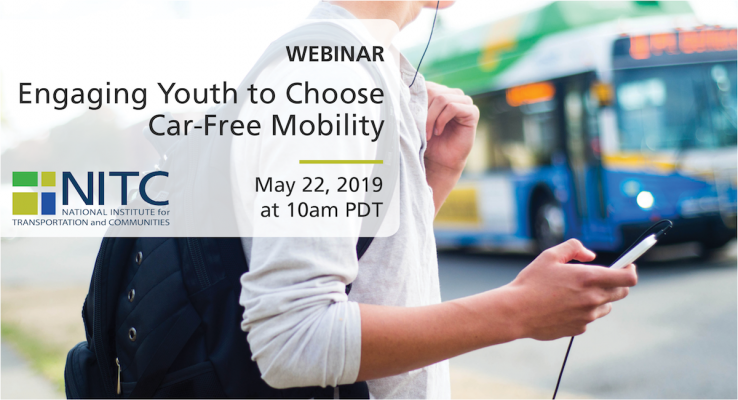The video begins at 3:10.
View slides
Watch video:
Successful public transit systems increase the value of locations they serve. Capturing this location value to help fund transit is often sensible, but challenging.
This presentation will define location value capture, and synthesize lessons learned from six European and North American transit agencies that have experience with location value capture funding.
The opportunities for and barriers to implementing location value capture fall into three categories:
- agency...
PRESENTATION ARCHIVE
Miss the webinar or want a look back?
OVERVIEW
Today’s youth are tomorrow’s riders, bikers, walkers, voters, and transportation planners. As more transit agencies begin to offer free fare passes to public middle and high school students, it is important to have good communication strategy in place to encourage transit usage so they don't miss out on the potential to affect behavior change.
Thus, transit agencies need to develop age-appropriate messaging strategies and tactics that promote youth car-free mobility.
This webinar will present results from a NITC research project that sought to create and evaluate communication messaging that fosters more positive attitudes, intentions, and behaviors related to transit and other car-free transportation options among Portland youth. While there is no "one size fits all" approach, the Portland-based findings may yield insights that could be adapted for application in other regions.
KEY LEARNING OUTCOMES...
Read moreThe video begins at 1:19.
View slides
Summary: Where and when does overcrowding happen on TriMet's bus network? Which routes have the best on-time performance? Portland State University and TriMet have collaborated to make this kind of data available to anybody through Portal, PSU's transportation data archive for the Portland/Vancouver region. This presentation will cover the use of General Transit Feed Specification (GTFS) data for mapping TriMet’s performance data and the development of Portal’s innovative transit application. In the MAP-21 era of performance management, see how tools like Portal can support enhanced agency decision-making as well as community engagement.
Bio: Jon Makler researches and teaches about transportation planning and engineering at Portland State University. His research portfolio centers on intelligent transportation systems, including how they can be harnessed to benefit the environment and how the data they generate can support operational strategies and planning decisions. Since moving to Oregon 9 years ago, he has worked at Metro, the City of Portland and OTREC, the federally-funded research center housed at PSU. His previous employers were the North Jersey Transportation Planning Authority, the Harvard Kennedy School, IBI Group and Sarah...
Read moreView slides
Abstract: Our speaker for May 14, 2010 is Gill V. Hicks, Director Southern California Operations for Cambridge Systematics, Inc. For more than ten years, Mr. Hicks served as the General Manager of the Alameda Corridor Transportation Authority (ACTA). The $2.4 billion Alameda Corridor consolidated harbor-related railroad traffic onto a single 20-mile corridor between the ports of Los Angeles and Long Beach and the railroad mainlines near downtown Los Angeles. Mr. Hicks’ responsibilities included overall management of the agency, building consensus, estimating benefits and costs of the project, generating political support, testifying before U.S. Congress, State Legislature, regulatory bodies, city councils, funding agencies and other stakeholders; developing a financial plan, raising funds, coordinating with railroad, trucking, and shipping businesses, and managing contracts for the project.
Mr. Hicks will discuss the major challenges faced by the project, including negotiations with three competing railroads, several municipal governments, utilities, regulatory agencies, contractors, and funding entities. The process for consensus building will be discussed. Major lessons learned will be described, including methods for reducing project risk, keeping on schedule and within budget. Mr. Hicks will also touch on the challenges facing the agency as...
Read moreWatch video
View slides
Summary: The Federal Transit Administration invests in building the capacity and improving the quality of public transportation throughout the United States of America. Under FTA's leadership, public rail, bus, trolley, ferry, and other transit services have reached greater levels of safety, reliability, availability, and accessibility. Come hear the highlights of FTA's impacts and participate in an interactive question/answer session and discussion on career options in public transportation!
Bio: Amy Changchien is the Director of Planning & Program Development of the Federal Transit Administration Region 10 Office in Seattle. Ms. Changchien has been a transportation professional for over 20 years, with experience spanning from highway to transit. In her career, she has worked on projects involving highway operations, Intelligent Transportation System, commuter rail, light rail, streetcar, ferries, and buses. Ms. Changchien holds a bachelor's degree in Civil Engineering and a master's degree in Public Administration from University of Washington.

